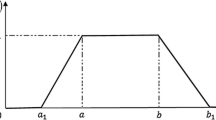Abstract
Using the structured element theory to solve the shortest path network about fuzzy weight. number, Firstly, the author introduced fuzzy structured element and related theory briefly. Then, the author proved the determined theorem of fuzzy network shortest path, it showed that: to solve shortest path of fuzzy network is equivalent to solving a classical network shortest-circuit. Finally, an example to illustrate the process of solving.
Access this chapter
Tax calculation will be finalised at checkout
Purchases are for personal use only
Preview
Unable to display preview. Download preview PDF.
Similar content being viewed by others
References
Dubois, D., Prade, H.: Systems of linear fuzzy constraints. Fuzzy Sets and Systems 17(3), 37–48 (1980)
Osaka, S., Gen, M.: Fuzzy Shortest Paths Problem. Computers Industrial Engineering 27(4), 465–468 (1994)
Osaka, S., Gen, M.: Order Relation between intervals and its application to shortest path problem. Computers Industrial Engineering 25(1), 147–150 (1994)
Osaka, S., Gen, M.: Order Relation between intervals and its application to shortest path problem. Computers Industrial Engineering 25(1), 147–150 (1994)
Liu, C., He, J., Shi, J.: New methods to solve fuzzy shortest path problems. Jornal of Southeast University 17(1), 18–21 (2001)
Guo, S.Z.: Structured element method of fuzzy analysis (Chinese). Journal of Liaoning technical University 21(5), 670–673, 21(6), 808–810 (2002)
Guo, S.Z., Su, z.x., Wang, L.: Method of structured element in fuzzy analysis. Fuzzy System and Math. 18(3), 68–75 (2004)
Guo, S.Z.: Principle of fuzzy mathematical analysis based on fuzzy structured element. North-east University Press, Shenyang (2004); 873; 21(6), 808–810, 82–83 (2004)
Author information
Authors and Affiliations
Editor information
Editors and Affiliations
Rights and permissions
Copyright information
© 2009 Springer-Verlag Berlin Heidelberg
About this paper
Cite this paper
Yue, Lz., Lai, Szg., Yan, Y. (2009). The Method of Fuzzy Network Shortest Path Based on the Structured Element Theory. In: Cao, B., Li, TF., Zhang, CY. (eds) Fuzzy Information and Engineering Volume 2. Advances in Intelligent and Soft Computing, vol 62. Springer, Berlin, Heidelberg. https://doi.org/10.1007/978-3-642-03664-4_24
Download citation
DOI: https://doi.org/10.1007/978-3-642-03664-4_24
Publisher Name: Springer, Berlin, Heidelberg
Print ISBN: 978-3-642-03663-7
Online ISBN: 978-3-642-03664-4
eBook Packages: EngineeringEngineering (R0)




